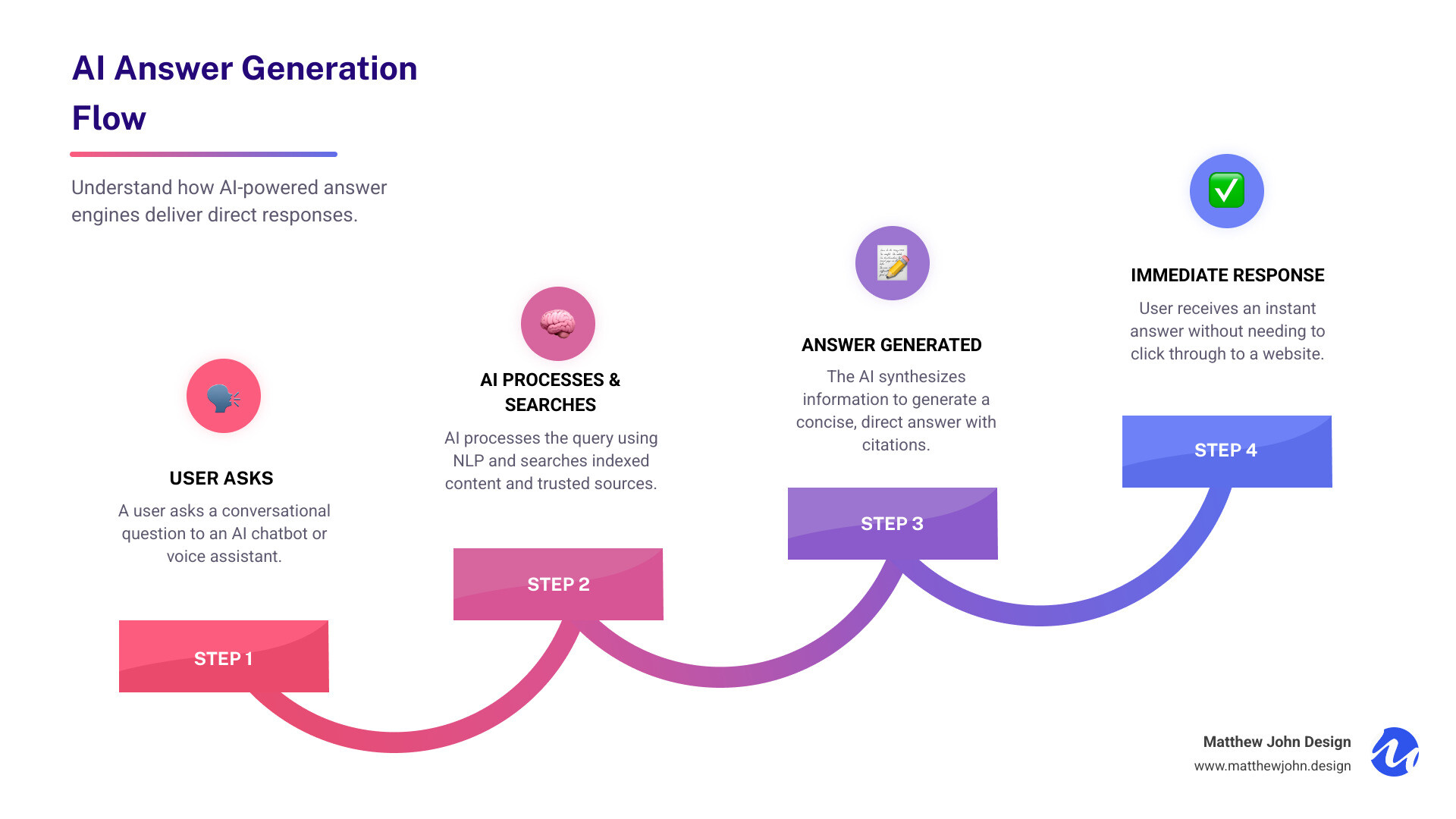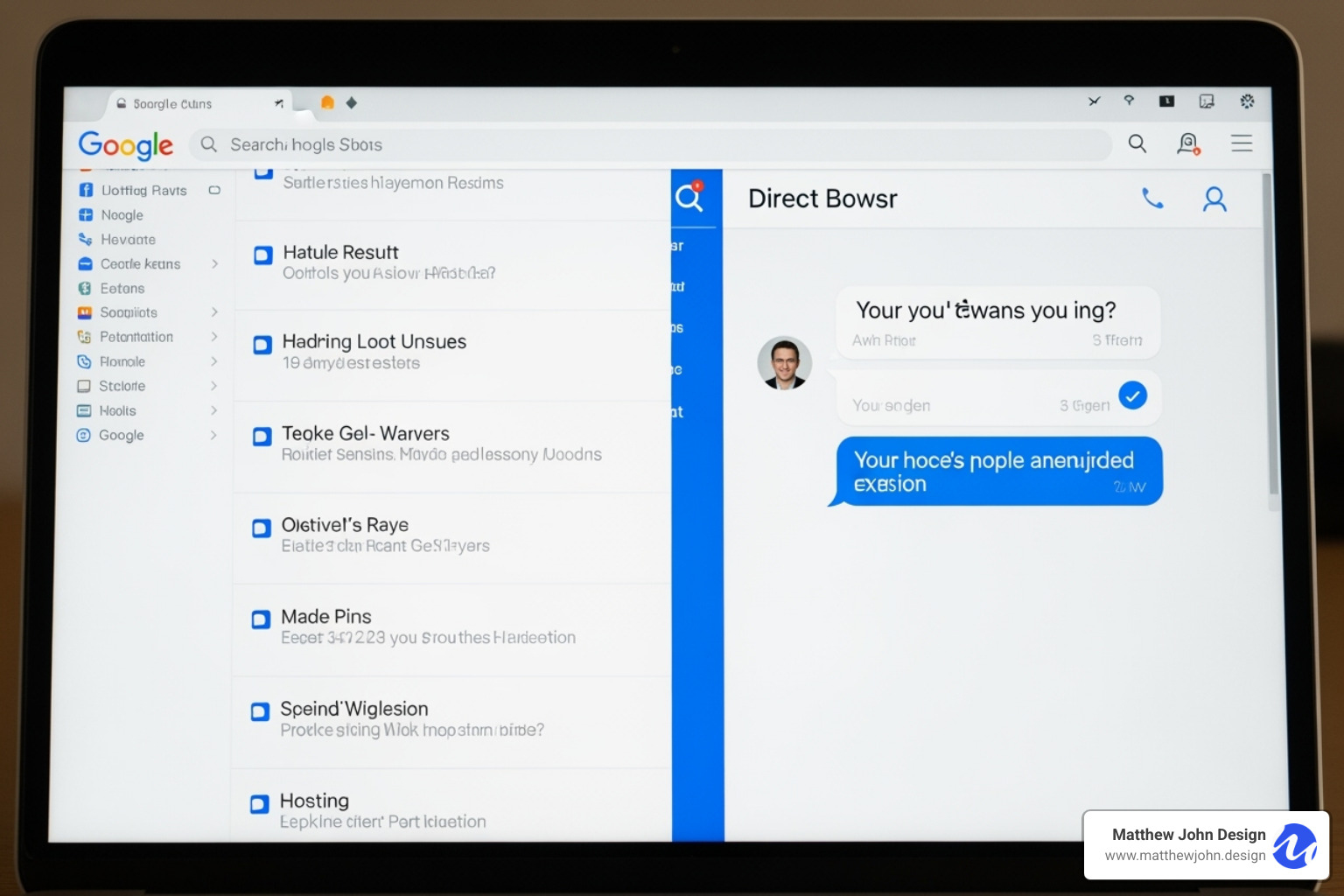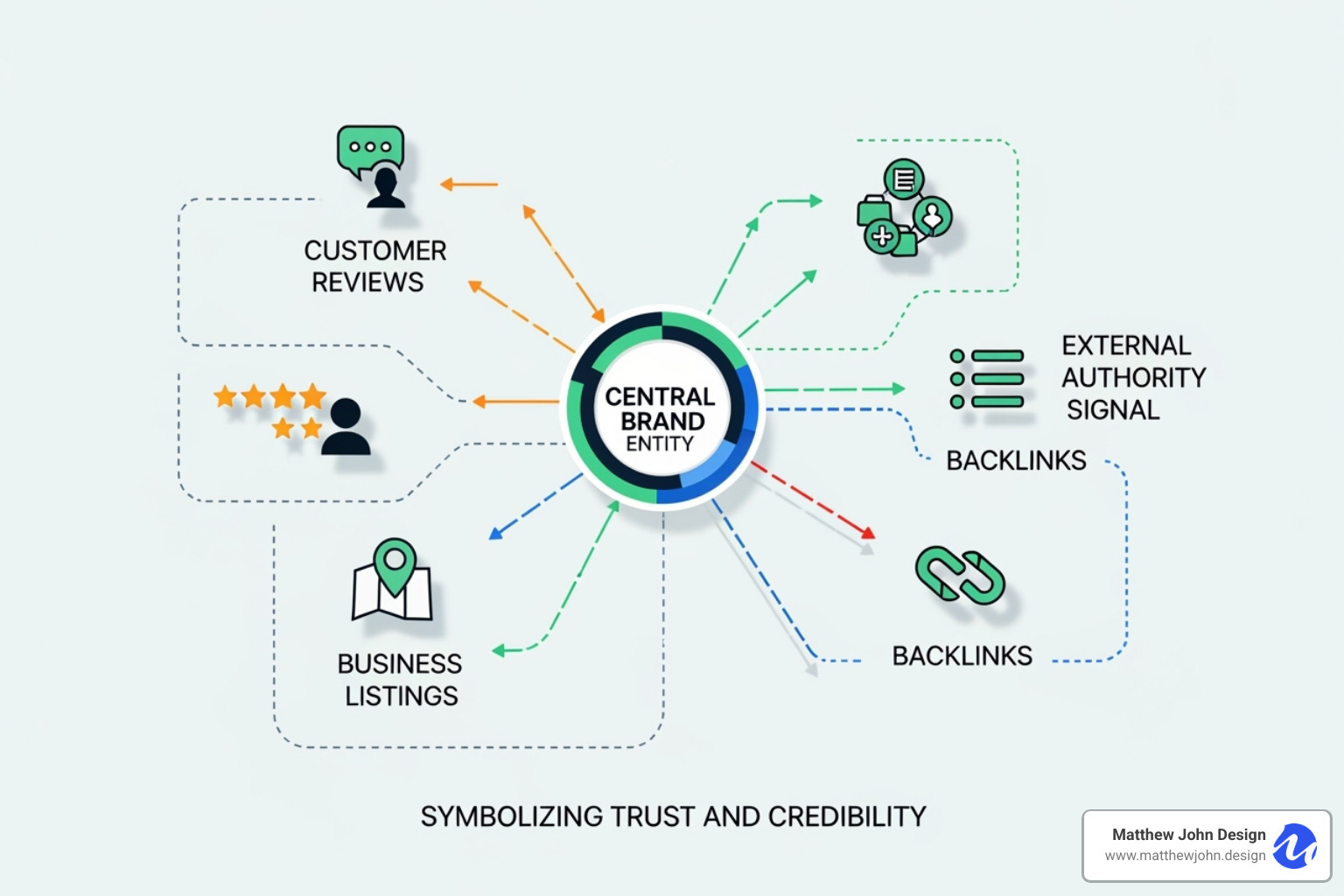Any information contained on this Website is not legal advice and should not be treated as such. You should always contact an attorney for help with your specific legal needs and issues. We may also earn a commission when you click links to our partners and purchase goods or services. For more information, read our Disclaimers Policy.
What is Answer Engine Optimization (AEO)?
What is answer engine optimization? It's the practice of optimizing your content to appear as direct answers on AI-powered platforms like ChatGPT, Google's AI Overviews, and voice assistants, moving beyond just ranking in traditional search results.
Key Components of AEO:
- Answer engines: AI chatbots and voice assistants that provide direct responses.
- Conversational queries: Natural language questions users ask AI platforms.
- Zero-click searches: Results where users get answers without visiting a website.
- Citations and mentions: How AI platforms reference your content as a source.
The search landscape is changing. Over half of Google searches end without a click, 400 million people use OpenAI products weekly, and Gartner predicts 25% of organic search traffic will shift to AI chatbots by 2026. This means businesses can't rely on traditional SEO alone. AEO focuses on becoming the source that AI platforms cite, competing for "position zero"—the direct answer a user receives.
The goal is no longer just visibility; it's about establishing authority, trust, and being recognized as the definitive source in your field.

The Goal: From a Link to The Answer
In the past, the primary SEO goal was to rank high in search results to drive clicks. The rise of AI answer engines has altered this objective. Now, the goal is to be the answer. This means shifting focus from earning clicks to earning citations and mentions within AI-generated responses. When an AI provides a direct answer, it often pulls information from a trusted source, giving that source an authoritative "position zero" placement that builds immense brand authority and user trust.
This highlights the impact of being "answered" by AI rather than just "clicked." For businesses, this means ensuring content is structured and authoritative enough to be the definitive source in their industry.
Key Answer Engine Platforms
The landscape of answer engines is diverse and expanding. To effectively implement what is answer engine optimization, we must understand the main players:
- Google Search Generative Experience (SGE): An AI-driven feature in Google’s search results that provides instant summaries and direct answers.
- Microsoft Copilot: An AI assistant embedded across Microsoft's ecosystem, including Bing search, that delivers interactive and contextually aware responses.
- ChatGPT and Gemini (formerly Bard): AI chatbots designed for in-depth conversations. ChatGPT's search relies on Bing's indexing system, so content optimized for Bing has a better chance of appearing in its responses.
- Multimodal Tools like Perplexity AI and Google Lens: These tools merge text, images, and video into unified, AI-powered responses, often with clear source citations.
Voice assistants like Siri, Alexa, and Google Assistant are also crucial. Optimizing for them means crafting concise, conversational content, as most voice answers are pulled from SERP features like Featured Snippets.
AEO vs. SEO: A Fundamental Shift from Clicks to Conversations

The rules of the game have changed. For years, we've focused on traditional SEO—researching keywords, building backlinks, and climbing search rankings. But what is answer engine optimization represents a different reality. The modern search experience is shifting from users hunting for information to having it delivered directly.
Core Differences in Strategy
The transition from SEO to AEO requires a fundamental shift in how we connect with our audience.
Traditional SEO is about earning clicks. We optimize pages to rank higher for specific keywords like "project management software" and measure success by ranking position and website traffic.
AEO competes to become the authoritative source that AI platforms cite. Instead of keywords, we focus on natural questions like "What project management tool works best for remote teams?" Success is measured by how often AI engines cite and mention our content as the definitive answer.
This doesn't mean abandoning SEO. AEO builds on a strong technical SEO foundation. Your content must still be crawlable, fast, and technically sound. Think of AEO as SEO's evolved form, optimizing for a different end goal: providing answers, not just driving traffic.
This might sound counterintuitive, but the strategy is proving effective. Companies that become the authoritative source cited by AI platforms build massive brand authority that drives value, even if it doesn't come from direct clicks.
How User Behavior is Driving the Change
We're adapting our strategies in response to how people consume information today. People want immediate answers, not a list of websites to research. AI provides that instant, step-by-step experience.
Conversational search is exploding. Instead of typing "best CRM small business," people now ask, "What's the best CRM for a startup with five employees?" This natural language shift requires content that answers real questions, which our AI-Driven SEO Content Creation approach addresses.
The numbers tell the story. More than half of all Google searches now end without a click, as users get answers from featured snippets or AI overviews. Gartner predicts that by 2026, 25% of traditional search traffic will shift to AI chatbots.
This is the new reality. Businesses that adapt now will own the conversations in their industries, while those that don't risk becoming invisible.
Why AEO is Crucial for Future-Proofing Your Business

Ignoring AI-powered search today is like ignoring mobile optimization a decade ago. The question isn't whether what is answer engine optimization will matter, but whether you'll adapt before your competitors.
The data is clear: 400 million people use OpenAI products weekly, and Microsoft's Bing mobile app downloads jumped 4x after adding AI. Gartner predicts that by 2026, a quarter of organic search traffic will shift to AI chatbots. This isn't a distant future; it's happening now.
The Rise of AI and Its Impact on Traffic
The traditional link between traffic and revenue is changing. For some brands, a drop in site traffic doesn't necessarily mean a drop in revenue. By becoming a trusted source for AI, they capture value through brand authority. Conversely, platforms like Stack Overflow saw traffic decline as users got answers directly from AI.
This shift means we must think beyond clicks and focus on how semantic SEO impacts the content creation process to make our content machine-readable. Businesses that position themselves as definitive answer sources will win, even if direct traffic patterns change.
Building Authority in the AI Era
Building authority for AI requires more than just backlinks. It's about becoming the source that AI systems consistently trust and cite.
E-E-A-T (Experience, Expertise, Authoritativeness, Trustworthiness) is more critical than ever, as AI models are trained to prioritize high-quality, reliable information. When your content demonstrates genuine expertise, AI engines are more likely to cite you.
This creates a powerful brand recall effect. When AI consistently mentions your company, users associate your brand with reliable expertise, making you the go-to name in your niche. Think of it as thought leadership amplified by AI, where your expert insights are actively promoted to users asking relevant questions.
The key is producing excellent content that satisfies user queries and meets the quality standards AI algorithms use to evaluate trustworthiness. This is why our approach to content marketing for SEO: ideas, creation steps focuses on creating comprehensive, authoritative content for both humans and AI.
Businesses that adapt their content strategy accordingly won't just survive the AI revolution—they'll dominate it.
Key Strategies for Effective Answer Engine Optimization
Implementing an effective AEO strategy involves a multi-faceted approach that combines content creation, technical optimization, and off-site authority building.
1. Crafting Answer-Focused Content
When you're figuring out what is answer engine optimization in practice, your content is your secret weapon. We're no longer just writing for humans; we're writing for AI systems that need to quickly extract the perfect answer.
People use conversational language with AI, asking, "What's the best project management tool for a team of 10?" instead of typing "best project management software." This shift to question-based keywords is critical for AEO.
Start by researching Google's "People Also Ask" section and consulting your customer service team—these are goldmines for the exact questions people are asking AI assistants.
Writing concise answers is crucial. AI models prefer direct, no-fluff responses. Google's featured snippets are often 40-50 words, so keeping your core answers brief dramatically improves your chances of being selected. Your full article can be long, but the core answer must be upfront.
The inverted pyramid structure is perfect for this. Lead with the direct answer, then provide supporting details. For a question like "How long does it take to build a website?" start with "Most custom websites take 4-8 weeks to build," and then explain the variables.
Make your content scannable with clear headings, bullet points, and short paragraphs. AI systems parse this structure easily, and humans appreciate the readability. This approach aligns with solid SEO content creation principles while optimizing for an AI-powered future. The goal is to make your expertise so clear and accessible that AI naturally chooses your content as the authoritative source.
2. Implementing Technical Signals for AI
Beyond content, we need to speak AI's language on a technical level. This means packaging your brilliant ideas so AI engines can easily find, understand, and share them. These are key on-page tactics for what is answer engine optimization.
One of the most important tools is structured data and Schema Markup. This code explicitly tells AI models what your content is about. For example, using FAQ Schema helps AI identify a list of questions and answers, making it easy to pull direct responses. Similarly, How-To schema clearly outlines step-by-step guides, helping your information appear in rich snippets and AI answers.
Site speed and mobile-friendliness are also crucial. AI models favor websites that load quickly and work perfectly on any device. Our Webflow sites are built with reusable components and a structured page-building system, which inherently supports the clean code and responsive design that AI crawlers favor. This foundation makes it much easier for AI to crawl and understand your content.
Crawlability ensures AI's web crawlers can explore and index your entire site. We manage this with a clean site structure, smart internal linking, and well-configured robots.txt files. If AI can't find your content, it can't cite it.
Clear website policies, like a Privacy Policy and Terms of Service, are essential for legal compliance and contribute to your site's overall trustworthiness, a factor AI models consider. Policy templates are a convenient way to create these essential documents.
Finally, for your video content, Webflow natively supports background videos up to 30MB. For larger videos, we always recommend third-party hosting solutions like YouTube, Vimeo, or Vidzflow. Accessible videos with good transcripts can also boost your AEO efforts.
All these technical signals help AI models identify and present your content as reliable answers. Ensuring your Webflow SEO Settings are dialed in is a huge step in the right direction.
3. Strengthening Off-Site Authority and Trust

While on-site optimizations are crucial, what is answer engine optimization truly succeeds when AI models can verify your authority from multiple external sources. Think of your brand as the center of a web of trust signals across the internet.
Quality backlinks remain a powerful trust signal. When reputable websites link to your content, they vouch for your expertise, and AI models prioritize content with strong backlink profiles.
Consistent business listings across Google Business Profile, industry directories, and local listings create a recognizable digital footprint. This helps build a knowledge graph entity, making it easier for AI to understand who you are and cite you as an authority.
Customer reviews on platforms like Google and Yelp offer powerful social proof. AI models can analyze the sentiment of reviews, and positive feedback signals that real people trust your business.
An active social media presence adds another layer of credibility. While not a direct ranking factor, it shows AI that you are a real, engaged business. Together, these off-site signals create a comprehensive digital identity that AI can understand and trust, making the difference between being just another website and being recognized as the trusted source.
Measuring AEO Success and Navigating Challenges
In what is answer engine optimization, success isn't always measured in clicks. This requires a new perspective on metrics and an honest look at the challenges.
Tracking Performance Beyond Clicks
Traditional SEO metrics are becoming outdated. We need new ways to measure what matters in the AI era.
- Citations and brand mentions are the new gold standard. When an AI platform cites your company, it's a win, even without a click. Tracking often requires manual searches or specialized tools.
- Search Console impressions for question-based queries can indicate that AI systems are considering your content for answers, even if clicks are low.
- Referral traffic from AI platforms like Perplexity AI exists, but studies show it's significantly lower than from traditional search. This is the new normal, not a sign of failure.
- Indirect conversions are a key, albeit harder to track, metric. A user might get your brand as an answer from an AI and convert later through a direct visit or different channel.
Overcoming AEO Implementation Problems
Implementing AEO involves navigating a constantly shifting landscape.
- Evolving algorithms: AI models are always changing, requiring constant strategy adjustments.
- Attribution difficulty: Connecting an AI-driven findy to a later conversion is complex and requires more than traditional analytics.
- Securing internal buy-in: Explaining the value of AEO can be challenging when stakeholders are focused on traffic metrics. Educating your team on brand authority and long-term value is key.
- Resource allocation: AEO demands dedicated time. Start with your highest-impact content and expand gradually.
- Accuracy concerns: AI can generate incorrect answers. This makes it even more critical that your source content is impeccably accurate to avoid being cited for misinformation.
Despite these challenges, adapting now is crucial. Our experience shows that the right technical foundation, as detailed in our guide on whether Is Webflow Good for SEO?, can help overcome many of these implementation problems.
Frequently Asked Questions about AEO
It’s natural to have questions about a field evolving as quickly as AEO. Here are some common inquiries about what is answer engine optimization.
How do AI answer engines source their content?
AI systems use a mix of technologies. At their core are Large Language Models (LLMs), which are trained on vast amounts of text and code to understand patterns and facts. To stay current beyond their training data, they use real-time data retrieval by sending out web crawlers, just like traditional search engines.
A key technique is Retrieval-Augmented Generation (RAG). Instead of just using its pre-trained knowledge, a RAG-enabled system actively searches for relevant, current information online and uses that specific content to formulate its answer. This reduces inaccuracies and provides more precise responses.
Finally, AI systems prioritize trusted sources. Your efforts in building E-E-A-T (Experience, Expertise, Authoritativeness, Trustworthiness) are vital. If your content is seen as reliable, AI engines are more likely to use it. For instance, ChatGPT's search relies on Bing's indexing system, so content well-optimized for Bing has a better chance of appearing in its responses.
How does AEO complement existing SEO strategies?
AEO doesn't replace SEO; it builds upon it. A strong SEO strategy is the foundation. Your content needs solid technical SEO, high quality, and good backlinks to even be on an AI's radar. Studies show that a significant percentage of AI Overview citations come from content already ranking in the top 10 organic search results.
AEO is an evolution that refines your SEO efforts for the direct-answer format AI models prefer. It adapts your content for conversational queries and structures it for easy digestion by AI. Both SEO and AEO value high-quality content, user intent, and technical health. The authority you build through traditional SEO directly signals trustworthiness to AI models. In short, SEO ensures you're found, while AEO ensures you're the answer.
What is the future outlook for AEO and AI-driven search?
The future of AI-driven search is personalized, integrated, and proactive.
Expect increased personalization, with AI tuning answers based on a user's history, preferences, and location. This means content must be both accurate and adaptable to various contexts. We'll also see deeper multimodal search integration, where text, voice, and image search merge into a single experience. Optimizing for tools like Google Lens will become more important.
AI may also become more proactive, delivering information before a user even asks. As algorithms continue to evolve, strategies will need to remain agile. Finally, legal and ethical considerations around content sourcing, copyright, and fair use will continue to shape how AI search operates, particularly regarding content attribution.
Conclusion: Integrate AEO to Win the Future of Search
The digital world is at a turning point. As AI-driven search becomes standard, understanding what is answer engine optimization is essential for staying relevant. AEO is not a replacement for your SEO efforts but a vital evolution, shifting the focus to providing direct, valuable answers that match user intent.
At Matthew John Design, we build smart, scalable Webflow sites with reusable components and CMS structures. This foundation enables your team to keep content fresh without developer delays and is perfect for AEO. By creating structured, authoritative content that directly answers user questions, we help you shine. Our Webflow sites are technically sound, fast, and mobile-friendly—qualities that position our clients as the trusted sources AI engines love to cite.
The future of search is conversational and immediate. Businesses that adapt now will thrive. We're here to guide you through this new landscape, ensuring your expertise is not just found, but delivered directly to those who need it most.
Ready to transform your digital strategy? Explore our SEO Writing & Video Services and let's start optimizing for answer engines together.

.jpg)